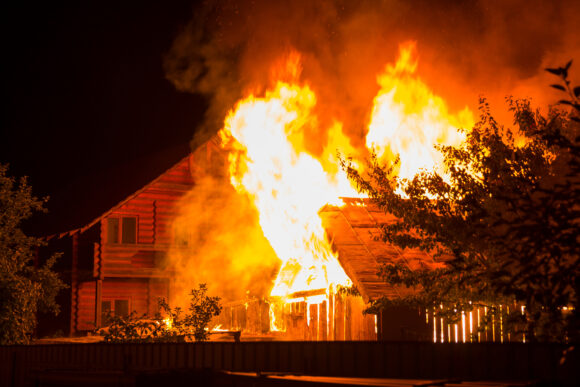“Climate-exacerbated wildfires” cost the nation $394 billion to $893 billion each year in economic costs and damages, according to a Congressional report out this week.
The range combines estimates from existing research on property damage, deaths and injuries, health impacts from wildfire smoke, income loss, watershed pollution and other factors.
“Each of these impacts on their own are very costly,” states the report from the Joint Economic Committee, chaired by Democratic Sen. Martin Heinrich (New Mexico). “Taken together, they represent disastrous consequences for the country.”
The costs and damages outlined in the report are equivalent to between 2% and 4% of U.S. GDP, well above existing estimates that put total wildfire costs at between $87.4 billion and $427.8 billion.
“The total cost estimates in this report should be viewed as a likely undercount of the true total cost, as there are several costs connected to wildfires that have not yet been fully quantified by researchers,” the report states. “These additional costs include: how post-fire erosion harms agriculture and makes mudslides and flooding more likely; post-wildfire rehabilitation costs to help burn scars and other parts of the ecosystem recover; and the costs of managed retreat when certain areas become too wildfire prone to live in.”
The report asserts that climate change will likely increase many of these costs going forward, as wildfires burn longer and produce more smoke.
Net-Zero Goals
A report from the National Academies of Sciences, Engineering, and Medicine has several new recommendations as part of a plan to put the U.S. on a pathway to the country’s net-zero carbon emissions goals by 2050.
This the second of two reports examining the nation’s transition to “a decarbonized energy system.” The latest report focuses on barriers to implementing of net-zero policies. The first report was a technical and policy blueprint.
The new report covers societal objectives and technological sectors. It includes more than 80 recommendations on private and public sector engagement.
Key suggestions in the report include:
- Congress should create a national greenhouse gas emissions budget, an economy-wide carbon tax with provisions to protect low-income people and standards on clean electricity generation and zero-emissions vehicles.
- The high-voltage interstate electricity grid should be expanded through permitting reforms, while local electric distribution systems should be modernized.
- Congress should designate an entity to execute transparent data analysis, monitoring, and public reporting.
- Require disclosure of more standardized data and information from companies to allow investors and regulators to better understand climate-related risks and opportunities.
Insurance and Climate
The problem that a growing number of Americans can less afford homeowners insurance may only worsen because insurers and lawmakers have underestimated the impact of climate change, a new report asserts.
A report from First Street Foundation shows states such as California, Florida and Louisiana, which are prone to wildfires and damaging storms and flooding, are likely to see the most dramatic increases in premiums. The fire that destroyed the Hawaiian community of Lahaina on Aug. 8, and the historic flooding that happened in Vermont and Maine in July, are other examples of events that could drive up insurance costs for homeowners in other states, according to the report.
“If you’re not worried, you’re not paying attention,” California state Sen. Bill Dodd, whose district includes the wine country counties devastated by wildfires in 2020, told the Associated Press in an article on Insurance Journal.
U.S. homeowners insurers have had three straight years of underwriting losses, according to AM Best. Losses for the first half of 2023 totaled $24.5 billion, roughly what was lost in all of 2022.
“(Climate change) is a problem that is already here,” Todd Bevington, a managing director at the insurance broker VIU by HUB, told the AP. In his 30 years in insurance, he said “I’ve never seen the market turn this quickly or significantly.”
Atlantic Hurricanes
Research by a climate scientist reveals significant changes to Atlantic hurricanes in the past 50 years, with storms developing and strengthening faster.
Rowan University professor Andra Garner found intensification rates from Atlantic hurricanes changed as greenhouse gas emissions warmed the planet and its oceans from 1971 to 2020. Garner’s study, Observed Increases in North Atlantic Tropical Cyclone Peak Intensification Rates, appeared in the journal Nature Scientific Reports.
“In the modern era, it is about as likely for hurricanes to intensify by at least 57 mph in 24 hours, and more likely for hurricanes to intensify by at least 23 mph within 24 hours than it was for storms to intensify by these amounts in 36 hours in the historical era,” she said for an article in Newswise. “The number of times that hurricanes strengthen from a Category 1 storm (or weaker) into a major hurricane (Category 3 or greater) within 36 hours has also more than doubled in the modern era relative to the historical era.”
The scientist found that Atlantic hurricanes developed from a Category 1 hurricane to a Category 3 or stronger in a 24-period faster than they did between 1970 and 1990. They are now more likely to strengthen faster along the east coast of the U.S. than they were during the previous period, Newswise reported.
“The increase in the number of times hurricanes turned from Category 1 or weaker to a major storm, (Category 3 or greater), is particularly concerning, since major hurricanes often produce the most damage in our coastal communities,” she said.
Past columns:
- Climate Change Can Cause U.S. Households ‘Significant Financial Strain’
- Report Examines Hot Summer Days Linked to Climate Change in U.S. Cities
- Report: Climate Change Boosts Risk of Extreme Wildfires 25%
- More Funding for U.S.-Based Provider of Retained Climate Risk Reinsurance
- Report: 244M in U.S. Felt at Least One July Day with Temps Likely Due to Climate Change
Was this article valuable?
Here are more articles you may enjoy.




 Is the AI Boom a Bubble Waiting to Pop? Here’s What History Says
Is the AI Boom a Bubble Waiting to Pop? Here’s What History Says  Kansas Man Sentenced to Probation for Insurance Fraud
Kansas Man Sentenced to Probation for Insurance Fraud  Howden US Tells Judge Brown & Brown Employees Fled Due to ‘Mistreatment’
Howden US Tells Judge Brown & Brown Employees Fled Due to ‘Mistreatment’  New York Regulates Consumer Litigation Financing
New York Regulates Consumer Litigation Financing 

